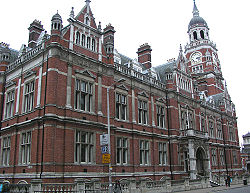Croydon Town Hall
| Croydon Town Hall | |
|---|---|
 Croydon Town Hall | |
| Location | Katharine Street,Croydon |
| Coordinates | 51°22′20″N0°05′56″W/ 51.37223°N 0.09896°W |
| Built | 1896 |
| Architect | Charles Henman |
| Architectural style(s) | Victorian style |
Listed Building– Grade II | |
| Designated | 19 November 1973 |
| Reference no. | 1188798 |
Croydon Town Hallis a council building in Katharine Street,Croydonwhich serves as the headquarters forCroydon London Borough Council.It is a Grade IIlisted building.[1]
History
[edit]Croydon's first town hall, which was located on the west side of the High Street, was initially intended as a market house and was completed in 1566: it was subsequently used as a town hall until it was demolished in 1807.[2]The second town hall, which was built on the site of the first town hall, was designed bySamuel Pepys Cockerellin theclassical styleand completed in 1808;[3]it was demolished as part of the town's High Street widening scheme in 1893.[4]
After civic leaders found that the town hall in the High Street was inadequate for their needs, they elected to construct a purpose-built town hall: they chose the site ofCentral Croydon railway station,which was redeveloped for council use in 1895, as part of a plan to install "Municipal Offices, Courts, a Police Station, Library and many other public purposes and yet leave a considerable margin of land which might be disposed of".[5]The building, which was designed by Charles Henman[6]in theVictorian styleand built in red brick by Messrs. W.H. Lascelles & Co, was officially opened by thePrinceandPrincess of Waleson 19 May 1896.[5]
The design involved a symmetrical main frontage with nine bays facing onto Katherine Street; the central section featured an arched porch on the ground floor; there was a large segmented window on the first floor and five narrow round headed windows on the second floor with the boroughcoat of armsabove.[1]A square clocktower, 176 feet (54 m) tall, was erected adjacent to the west of the main building.[1]The clock and bells were made by the Croydon firm ofGillett & Johnston.[7]Above each clockface was akeystonecarved in the form of a human head, representing respectively the fourcardinal pointsof the compass: an "Esquimaux"(north), a"Hottentot"(south), a"Chinaman"(east) and an"American Indian"(west).[7]To the west of the clocktower was Braithwaite Hall, with pitched roof andturret,and the corn exchange, withloggia.[1]Braithwaite Hall was named after the Revd John Masterman Braithwaite (1846–1889), a former vicar of Croydon.[8][a]Internally, the principal rooms were the council chamber, the mayor's parlour and the committee rooms.[5]
A statue ofQueen Victoria,which was sculpted byFrancis John Williamson,was erected outside the town hall in 1903.[10]Awar memorial,designed byJames Burfordand incorporating two bronze sculptures byPaul Raphael Montford,was erected in 1921.[11]
The building served as the headquarters of theCounty Borough of Croydonfor much of the 20th century and went to become the local seat of government of the enlargedLondon Borough of Croydonon its formation in 1965.[12]Council officers and their departments moved out toTaberner House,located to the south east of the town hall, in 1967.[13]The building continued to be used as a judicial facility until the combined courts centre in Barclay Road opened in 1968.[14][15]
The whole building, including the council chamber, the mayor's parlour and committee rooms, was extensively renovated in the late-1980s and early 1990s. This enabled parts of the building which were not required for council meetings to be re-purposed as an arts venue known as theCroydon Clocktowerin 1994.[16]At the same time a newpublic librarywas established in a new structure behind the town hall and the old local studies library was converted for use as the newDavid Lean Cinema.[5]Meanwhile, Braithwaite Hall continued to be made available for concerts, theatre and children's shows.[17]
After Taberner House became inefficient to operate, council officers and their departments moved toBernard Weatherill House,located to the south of the town hall, in May 2013.[18]
Notes
[edit]- ^John Braithwaite was the father of the actress,Lilian Braithwaite.[9]
References
[edit]- ^abcdHistoric England."Municipal Buildings, comprising the clock tower, public library, and Corn Exchange, and including the area balustrade which incorporates a war memorial and a statue of Queen Victoria (1188798)".National Heritage List for England.Retrieved5 April2020.
- ^Brayley, Edward Wedlake; Britton, John (17 September 2017)."A topographical history of Surrey, by E.W. Brayley assisted by J. Britton and E.W. Brayley, jun. The geological section by G. Mantell"– via Google Books.
- ^Anderson, John Corbet (17 September 1882).A Short Chronicle Concerning the Parish of Croydon in the County of Surrey.Ballantyne, Hanson and Company. p. 201 – via Internet Archive.
croydon town hall.
- ^"London's Town Halls".Historic England. p. 42.Retrieved25 April2020.
- ^abcd"Town Hall".8 April 2014.Retrieved16 September2017.
- ^Cherry, Bridget; Pevsner, Nikolaus (1983).London 2: South.Buildings of England series.Penguin Books. p. 214.ISBN0-14-071047-7.
- ^abAnon. 1896, pp. 12–13.
- ^"Braithwaite Hall, Croydon Clocktower, London".The Independent.23 January 1996.Retrieved15 November2020.
- ^Morgan, Diana; Reynolds, K. D. (revised) (2004). "Braithwaite [married name Lawrence], Dame (Florence) Lilian (1873–1948)".Oxford Dictionary of National Biography(online ed.). Oxford University Press.doi:10.1093/ref:odnb/32036.(Subscription orUK public library membershiprequired.)
- ^"Statue: Queen Victoria statue – Croydon".London Remembers.Retrieved5 April2020.
- ^Historic England."Croydon War Memorial (Grade II*) (1268438)".National Heritage List for England.Retrieved15 January2021.
- ^"Local Government Act 1963".Legislation.gov.uk.Retrieved25 April2020.
- ^"Taberner House, London".Skyscraper News.Retrieved23 April2020.
- ^Mulcahy, Linda; Rowden, Emma (2019).The Democratic Courthouse: A Modern History of Design, Due Process and Dignity.Taylor and Francis.ISBN978-0429558689.
- ^"Law Courts and Courtrooms 2: Civil and Coroner's Courts".Historic England. 1 August 2016. p. 10.Retrieved26 February2023.
- ^"David Lean Cinema returns to Croydon Clocktower Auditorium".East London Lines. Archived fromthe originalon 29 January 2018.Retrieved5 April2020.
- ^"Concert: Ida's march".News Shopper.11 September 2002.Retrieved15 November2020.
- ^"Bernard Weatherill House".Open House London. Archived fromthe originalon 19 January 2019.Retrieved23 April2020.
Further reading
[edit]- Anon. (1896).Some Account of the Municipal Buildings, Croydon, in commemoration of the opening by H.R.H. the Prince of Wales K.G. &c. 19th May 1896. With several views.Croydon.
{{cite book}}:CS1 maint: location missing publisher (link)



